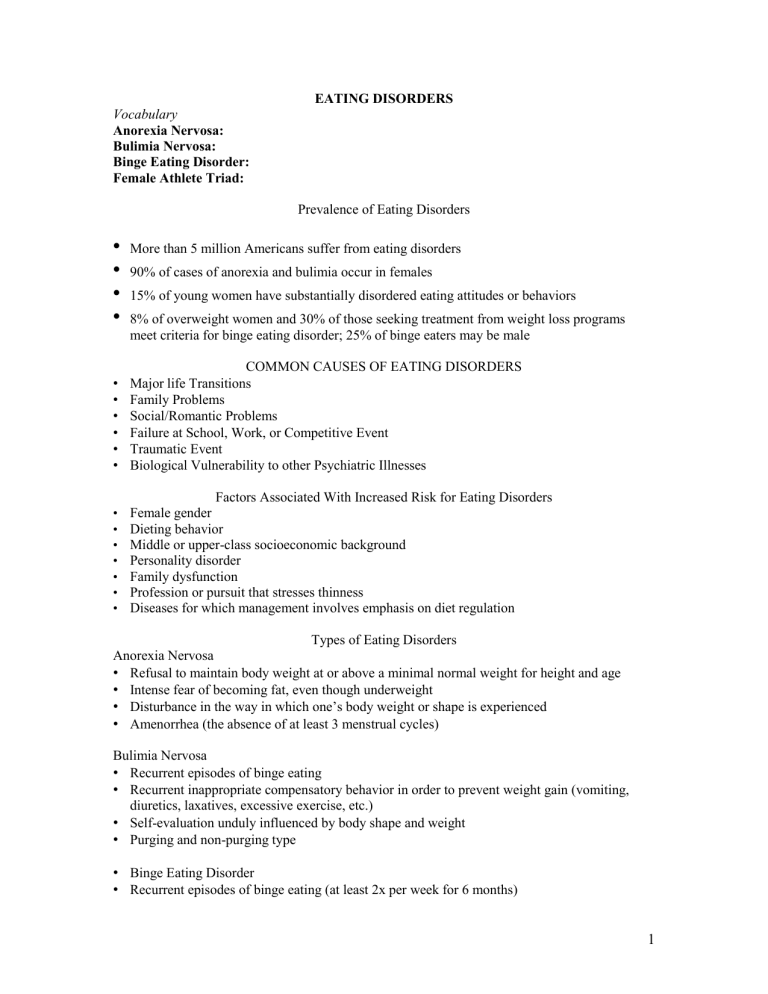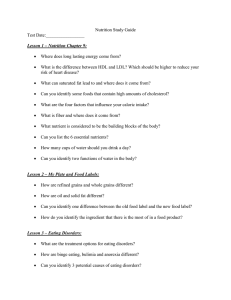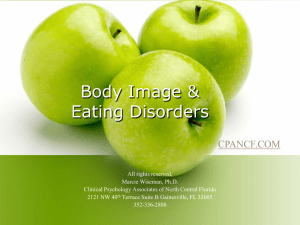•

EATING DISORDERS
Vocabulary
Anorexia Nervosa:
Bulimia Nervosa:
Binge Eating Disorder:
Female Athlete Triad:
Prevalence of Eating Disorders
•
More than 5 million Americans suffer from eating disorders
•
90% of cases of anorexia and bulimia occur in females
•
15% of young women have substantially disordered eating attitudes or behaviors
•
8% of overweight women and 30% of those seeking treatment from weight loss programs meet criteria for binge eating disorder; 25% of binge eaters may be male
•
•
•
•
•
•
•
COMMON CAUSES OF EATING DISORDERS
•
Major life Transitions
•
Family Problems
•
Social/Romantic Problems
•
Failure at School, Work, or Competitive Event
•
Traumatic Event
•
Biological Vulnerability to other Psychiatric Illnesses
Factors Associated With Increased Risk for Eating Disorders
Female gender
Dieting behavior
Middle or upper-class socioeconomic background
Personality disorder
Family dysfunction
Profession or pursuit that stresses thinness
Diseases for which management involves emphasis on diet regulation
Types of Eating Disorders
Anorexia Nervosa
•
Refusal to maintain body weight at or above a minimal normal weight for height and age
•
Intense fear of becoming fat, even though underweight
• Disturbance in the way in which one’s body weight or shape is experienced
•
Amenorrhea (the absence of at least 3 menstrual cycles)
Bulimia Nervosa
•
Recurrent episodes of binge eating
•
Recurrent inappropriate compensatory behavior in order to prevent weight gain (vomiting, diuretics, laxatives, excessive exercise, etc.)
•
Self-evaluation unduly influenced by body shape and weight
•
Purging and non-purging type
•
Binge Eating Disorder
•
Recurrent episodes of binge eating (at least 2x per week for 6 months)
1
•
The binge eating causes marked distress
•
The binge eating is not associated with the regular use of inappropriate compensatory behaviors
•
The Female Athlete Triad
•
Eating Disorder – restrictive dieting, excessive exercise, weight loss, lack of body fat
•
Amenorrhea – diminished hormones (may be as high as 66% in female athletes)
•
Compromised Bone Health – stress fractures now, osteoporosis later in life
Distinguishing Between Normal and Abnormal Athletic Training
Athletes
•
Purposeful training
•
Increased exercise tolerance
•
Good muscle development
•
Accurate body injury
Anorexia “Athletica”
•
Aimless activity
•
Reduced exercise tolerance
•
Reduced musculature
•
Distorted body image
Amenorrhea
•
Critical low fat theory?
•
Excessive exercise?
•
Energy drain?
PHYSICAL AND MEDICAL EFFECTS OF EATING DISORDERS
ANOREXIA NERVOSA
• sallow complexion, dry skin, hair loss, hollow facial features
• irregular or ceased menstruation; infertility; osteoporosis
• changes in metabolism and energy
• cardiac problems, low blood pressure, fatigue, dizziness
BULIMIA NERVOSA
• damaged teeth, swollen cheeks, dehydration, weakness
• electrolyte imbalance, muscle spasms, headaches, fatigue
•
GI problems, kidney problems
BINGE EATING DISORDERS
•
obesity related diabetes, high blood pressure, high cholesterol, risk of stroke, sleep apnea, gall bladder disease and several forms of cancer
2
Treatment
•
Comprehensive Multidimensional Assessment
physical exam, mental health evaluation, nutritional counseling
•
Coordinated Care Plan
team of eating disorders professionals
nutritional rehabilitation/restoration of normal eating patterns and long-term goals
•
Psychotherapy
cognitive behavioral, interpersonal
individual, family, group
Prevention
For eating disorders PREVENTION is key! What can we do?
3




